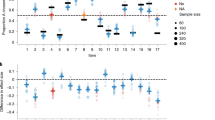Abstract
This paper tests a novel implication of the original version of prospect theory (Kahneman and Tversky, 1979): that choices may systematically violate transitivity. Some have interpreted this implication as a weakness, viewing it as an anomaly generated by the ‘editing phase’ of prospect theory which can be rendered redundant by an appropriate re-specification of the preference function. Although there is some existing evidence that transitivity fails descriptively, the particular form of non-transitivity implied by prospect theory is quite distinctive and hence presents an ideal opportunity to expose that theory to test. An experiment is reported which reveals strong evidence of the predicted intransitivity. It is argued that the existence of this new form of non-transitive behaviour presents a fresh theoretical challenge to those seeking descriptively adequate theories of choice behaviour, and a particular challenge to those who seek explanations within the conventional economic paradigm of utility maximisation.
Similar content being viewed by others
REFERENCES
Harless,W. and Camerer, C. (1994), The predictive utility of generalised expected utility theories, Econometrica62: 1251–1289.
Dawes, R. (1979), The robust beauty of improper linear models in decision making, American Psychologist34: 571–582.
Edwards, W. (1954), Probability-preferences among bets with differing expected value, American Journal of Psychology67: 56–67.
Eliashberg, J. and Hauser, J. (1985),A measurement error approach for modelling consumer risk preference, Management Science31: 1–23.
Fishburn, P. (1982), Nontransitive measurable utility, Journal of Mathematical Psychology26: 31–67.
Hey, J. and Orme, C. (1994), Investigating generalizations of expected utility theory using experimental data, Econometrica62: 1291–1326.
Hershey, J. and Schoemaker, P. (1985), Probability versus certainty equivalence methods in utility measurement: are they equivalent?, Management Science31: 1213–1331.
Holt, C.A. (1986), Preference reversals and the independence axiom, American Economic Review76: 263–291.
Kahneman, D. and Tversky, A. (1979), Prospect theory: an analysis of decision under risk, Econometrica47: 263–291.
Loomes, G., Starmer, C. and Sugden, R. (1989), Preference reversal, information processing effect or rational non-transitive choice, Economic Journal99 (supplement): 140–152.
Loomes, G., Starmer, C. and Sugden, R. (1991), Observing violations of transitivity by experimental methods, Econometrica59: 425–439.
Loomes, G. and Sugden, R. (1982), Regret theory: an alternative theory of rational choice under uncertainty, Economic Journal92: 805–824.
Loomes, G. and Sugden, R. (1987), Some implications of a more general form of regret theory, Journal of Economic Theory41: 270–287.
Loomes, G. and Sugden, R. (1995), incorporating a stochastic element into decision theories, European Economic Review39: 641–648.
Machina, M. (1982), 'Expected utility’ analysis without the independence axiom, Econometrica50: 277–323.
Machina, M. (1983), The economic theory of individual behaviour toward risk: theory, evidence and new directions, Technical Report No. 433, Center for Research on Organizational Efficiency, Stanford University, California.
Neumann, J. von and Morgenstern, O. (1946), The Adaptive Decision Maker, Cambridge, UK: Cambridge University Press.
Quiggin, J. (1982), A theory of anticipated utility, Journal of Economic Behaviour and Organization3: 323–343.
Quiggin, J. (1993), Generalized Expected Utility Theory, Dordrecht, London, Boston: Kluwer.
Rubinstein, A. (1988), Similarity and decision-making under risk, Journal of Economic Theory46: 145–153.
Simon, H. (1955), A behavioral model of rational choice, Quarterly Journal of Economics69: 99–118.
Schoemaker, J. and Waid, C. (1988), A probabilistic dominance measure for binary choices: analytic aspects of a multi-attribute random weights model, Journal of Mathematical Psychology42: 169–191.
Starmer, C. and Sugden, R. (1991), Does the random-lottery incentive system elicit true preferences?, American Economic Review81: 971–979.
Tversky, A. (1969), Intransitivity of preferences, Psychological Review76: 31–48.
Tversky, A. (1972), Elimination by aspects: a theory of choice, Psychological Review79: 281–299.
Tversky, A. and Kahneman, D.P. (1986), Rational choice and the framing of decisions, Journal of Business59: S251–278.
Tversky,A. and Kahneman, D.P. (1992),Advances in prospect theory: cumulative representation of uncertainty, Journal of Risk and Uncertainty5: 297–323.
Tversky, A., Slovic, P. and Kahneman, D. (1990), The causes of preference reversal, American Economic Review80: 204–217.
Author information
Authors and Affiliations
Rights and permissions
About this article
Cite this article
Starmer, C. Cycling with Rules of Thumb: An Experimental Test for a new form of Non-Transitive Behaviour. Theory and Decision 46, 139–157 (1999). https://doi.org/10.1023/A:1004930205037
Issue Date:
DOI: https://doi.org/10.1023/A:1004930205037




